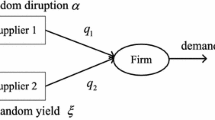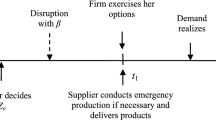Abstract
This paper considers a buyer that procures from its major supplier whose production is subject to random yield risk. To mitigate supply risk, the buyer can procure from another reliable supplier who provides quantity flexibility (QF) contract. Under both deterministic and stochastic demand, we study the buyer’s optimal procurement decisions. We analyze the structural properties of optimal solutions and identify the conditions under which the quantity flexibility procurement policy should be used. We also examine the effect of supply risk, flexibility, wholesale price and demand risk on the procurement decisions. We find that the higher supply risk and demand risk reduce the buyer’s profit but have different impact on the buyer’s order policy. For the QF supplier, it may not obtain more orders by providing larger flexibility to the buyer, on the contrary, doing this may benefit the risky supplier. For the QF supplier or risky supplier, given its competitor’s wholesale price, it can increase its order share by lower wholesale price.




Similar content being viewed by others
References
Agrawal, N., & Nahmias, S. (1997). Rationalization of the supplier base in the presence of yield uncertainty. Production and Operations Management, 6(3), 291–308.
Cachon, G. P. (2003). Supply chain coordination with contracts. In S. Graves & T. de Kok (Eds.), Handbooks in operations research and management science: Supply chain management (p. 6). North-Holland: Elsevier.
Chao, X., Gong, X., & Zheng, S. (2016). Optimal pricing and inventory policies with reliable and random-yield suppliers: Characterization and comparison. Annals of Operations Research, 241(1–2), 35–51.
Chen, W., Feng, Q., & Seshadri, S. (2013). Sourcing from suppliers with random yield for price-dependent demand. Annals of Operations Research, 208, 557–579.
Chen, K. B., & Yang, L. (2014). Random yield and coordination mechanisms of a supply chain with emergency backup sourcing. International Journal of Production Research, 52(16), 4747–4767.
Chung, W., Talluri, S., & Narasimhan, R. (2010). Flexibility or cost saving? Sourcing decisions with two suppliers. Decision Sciences, 41, 623–650.
Dada, M., Petruzzi, N. C., & Schwarz, L. B. (2007). A newsvendor’s procurement problem when suppliers are unreliable. Manufacturing and Service Operations Management, 9(1), 9–32.
Federgruen, A., & Yang, N. (2008). Selecting a portfolio of suppliers under demand and supply risks. Operations Research, 56(4), 916–936.
Guo, S., Zhao, L., & Xu, X. (2016). Impact of supply risks on procurement decisions. Annals of Operations Research, 241(1–2), 411–430.
Gurnani, H., & Gerchak, Y. (2007). Coordination in decentralized assembly systems with uncertain component yields. European Journal of Operational Research, 176, 1559–1576.
He, B., Huang, H., & Yuan, K. (2015). The comparison of two procurement strategies in the presence of supply disruption. Computers & Industrial Engineering, 85, 296–305.
He, B., Li, G., & Liu, M. (2016). Impacts of decision sequences on a random yield supply chain with a service level requirement. Annals of Operations Research. https://doi.org/10.1007/s10479-016-2275-4.
He, Y., & Zhang, J. (2008). Random yield risk sharing in a two-level supply chain. International Journal of Production Economics, 112(2), 769–781.
Hu, F., Lim, C., & Lu, Z. (2013). Coordination of supply chains with a flexible ordering policy under yield and demand uncertainty. International Journal of Production Economics, 146(2), 686–693.
Keren, B. (2009). The single-period inventory problem: Extension to random yield from the perspective of the supply chain. Omega, 37(4), 801–810.
Li, X. (2017). Optimal procurement strategies from suppliers with random yield and all-or-nothing risks. Annals of Operations Research, 257(1–2), 167–181.
Okyay, H. K., Karaesmen, F., & Zekici, S. (2014). Newsvendor models with dependent random supply and demand. Optimization Letters, 8(3), 983–999.
Porteus, E. L. (2002). Foundations of stochastic inventory theory. Stanford: Stanford University Press.
Sethi, S. P., Yan, H., & Zhang, H. (2004). Quantity flexibility contracts: Optimal decisions with information updates. Decision Sciences, 35(4), 691–712.
Sting, F. J., & Huchzermeier, A. (2010). Ensuring responsive capacity: How to contract with backup suppliers. European Journal of Operational Research, 207(2), 725–735.
Tang, S. Y., & Kouvelis, P. (2014). Pay-back-revenue-sharing contract in coordinating supply chains with random yield. Production and Operations Management, 23, 2089–2102.
Tomlin, B. (2006). On the value of mitigation and contingency strategies for managing supply chain disruption risk. Management Science, 52(5), 639–657.
Tsay, A. T. (1999). The quantity flexibility contract and supplier-customer incentives. Management Science, 45(10), 1339–1358.
Tsay, A. T., & Lovejoy, W. S. (1999). Quantity flexibility contracts and supply chain performance. Manufacturing & Service Operations Management, 1(2), 89–111.
Wu, M., Zhu, S. X., & Teunter, R. H. (2013). The risk-averse newsvendor problem with random capacity. European Journal of Operational Research, 231(2), 328–336.
Xia, Y., Ramachandran, K., & Gurnani, H. (2011). Sharing demand and supply risk in a supply chain. IIE Transactions, 43(6), 451–469.
Xu, H. (2010). Managing production and procurement through option contracts in supply chains with random yield. International Journal of Production Economics, 126(2), 306–313.
Yan, X., Ji, Y., & Wang, Y. (2012). Supplier diversification under random yield. International Journal of Production Economics, 139(1), 302–311.
Yang, W., & Wu, E. (2008). Manufacturing a brand. http://www.amcham-shanghai.org/.
Yano, C. A., & Lee, H. L. (1995). Lot-sizing with random yields: A review. Operations Research, 43(3), 311–334.
Acknowledgements
We appreciate for the referee’s comments on this paper, which significantly improved this paper. The authors acknowledge Xia Zhang for her assistance with the computational work in this paper. This work is supported by the National Natural Science Foundation of China (Grant No. 71572021).
Author information
Authors and Affiliations
Corresponding author
Rights and permissions
About this article
Cite this article
He, B., Yang, Y. Mitigating supply risk: an approach with quantity flexibility procurement. Ann Oper Res 271, 599–617 (2018). https://doi.org/10.1007/s10479-018-2840-0
Published:
Issue Date:
DOI: https://doi.org/10.1007/s10479-018-2840-0




